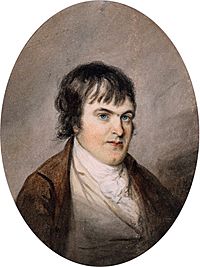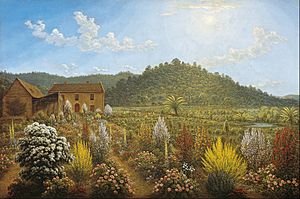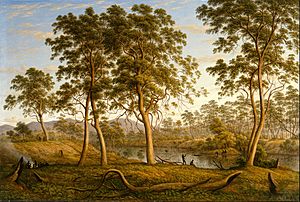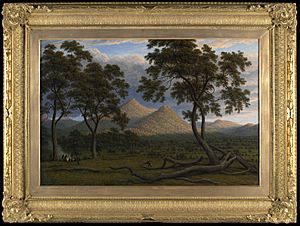John Glover (artist) facts for kids
Quick facts for kids
John Glover
|
|
|---|---|

John Glover
|
|
| Born | 18 February 1767 Houghton on the Hill, Leicestershire, England
|
| Died | 9 December 1849 (aged 82) |
| Nationality | British |
| Education | Free School, Appleby |
| Known for | Landscape |
|
Notable work
|
'Hobart Town, taken from the garden where I lived', 1832 'Mount Wellington and Hobart Town from Kangaroo Point' 1831–33 'Natives on the Ouse River, Van Diemen's Land', 1838 'Natives at a corrobory, under the wild woods of the Country [River Jordan below Brighton, Tasmania]', ca. 1835 'A view of the artist's house and garden, in Mill's Plains, Van Diemen's Land', 1835 |
| Movement | Claudean style, picturesque |
| Spouse(s) | Sarah |
| Awards | Louis XVIII gold medal (for 'Bay of Naples') |
John Glover (born February 18, 1767 – died December 9, 1849) was a famous artist from England. Later in his life, he moved to a place called Van Diemen's Land, which is now Tasmania, Australia. There, he became a farmer. Many people call him "the father of Australian landscape painting" because of his amazing artworks.
Contents
Life as a Painter in Britain
John Glover was born in Houghton on the Hill in Leicestershire, England. His parents were William and Ann Glover. From a young age, he showed a great talent for drawing.
By 1794, he was working as an artist and a drawing teacher. He taught art in towns like Lichfield and Aldridge. A noblewoman, the Countess of Harrington, helped him start his teaching career. She might have even taken lessons from him herself.
In 1805, Glover moved to London. He joined the Old Water Colour Society, a group for artists who used watercolors. In 1807, he was chosen as its president. Over the next few years, he showed many of his paintings at exhibitions. These included shows by his society, the Royal Academy, and the Society of British Artists.
Glover also had his own art shows in London in 1823 and 1824. He was a very successful artist. Even though he was never made a full member of the Royal Academy, people really admired his work.
Glover became famous for painting beautiful, romantic landscapes. These often looked like Italian scenes, even when they were of places in Britain. He painted areas like The Falls of Foyers in Scotland, the Lake District, and London. He was known in England and France as the English Claude. This compared him to a famous French artist from the 1600s, Claude Lorrain. Claude's paintings greatly influenced English art and garden design.
Moving to Australia
Glover decided to move to Australia. He arrived in Van Diemen's Land (now Tasmania) on his 64th birthday in 1831. He came with a strong reputation as a landscape painter.
From April 1831 to early 1832, he lived in Hobart. His home was on a property called "Stanwell Hall." You can see this house in his painting Hobart Town, taken from the garden where I lived.
In 1832, he bought a very large piece of land at Mills Plains near Deddington. He named his new property Patterdale. This name came from a place near Ullswater in the Lake District of England, where he had lived before.
Glover helped build a chapel in Deddington. He is also buried in the grounds of this chapel.
Painting the Australian Landscape


Today, Glover is best known for his paintings of the Tasmanian landscape. He painted the Australian sunlight in a new way. His works showed the bushland as bright and clear. This was different from the darker style used for "English country gardens." An example of this is his painting Patterdale Farm (around 1840).
His way of painting local plants was also new. He showed Australian trees and scrubland more accurately. Glover noticed how "remarkable" the trees were in Australia. He observed that "however numerous, they rarely prevent your tracing through them the whole distant country." This means you could often see far into the distance through the trees.
One of his paintings, Natives on the Ouse River, Van Diemen’s Land (1838), shows Aboriginal people in the landscape. Some art experts believe this painting shows an idea of Australia as a perfect, untouched place. However, Glover did have some experience with Aboriginal Tasmanian people.
John Glover painted his last major artwork on his 79th birthday.
Glover's Legacy in Australia
The John Glover Society was started on August 22, 2001. Its goal is to honor John Glover and his important role in Australian art. The society ordered a life-size statue of Glover. It was revealed in February 2003 in Evandale, Tasmania. The society also holds an annual art competition called the Glover Prize in Evandale.
John Glover's paintings are displayed in many major art galleries. You can find his work in Australia and around the world. His art has been featured in many exhibitions and special events in Australia.
Since 2004, the John Glover Society has given out the Glover Prize. This prize is for paintings of Tasmanian landscapes. It is the most valuable art prize in Australia for landscape painting.
In 2019, the farmhouse where the Glover family once lived was restored. This house is southeast of Launceston. About 400 hectares (almost 1,000 acres) of land around it were also protected. This land often appeared in Glover's paintings. It is now listed as 'Patterdale and Nile Farm' on the Tasmanian Heritage Register.
In 2021, an old sketchbook by John Glover was sold at an auction. It was from the early 1800s and had 90 pages of his drawings. The sketchbook sold for AU$150,000 to a private collector in Tasmania. It was first listed for about $5,500. The auction had over 1,000 online bidders, showing how popular Glover's work still is.


